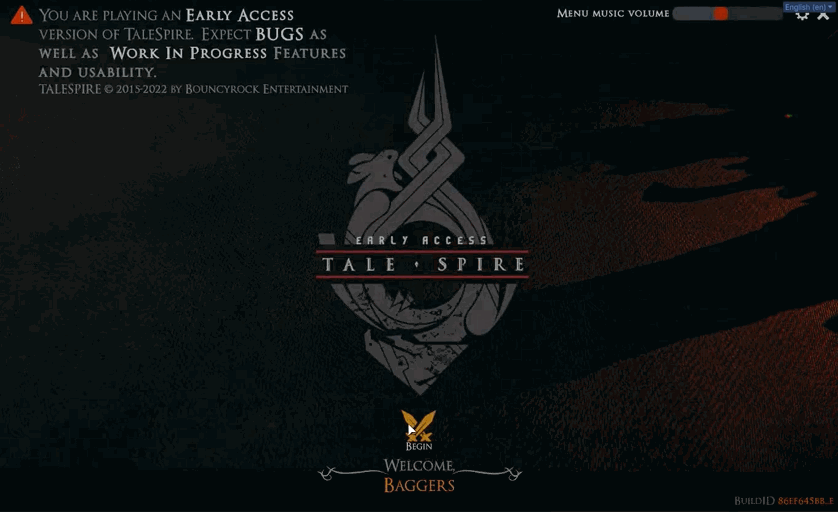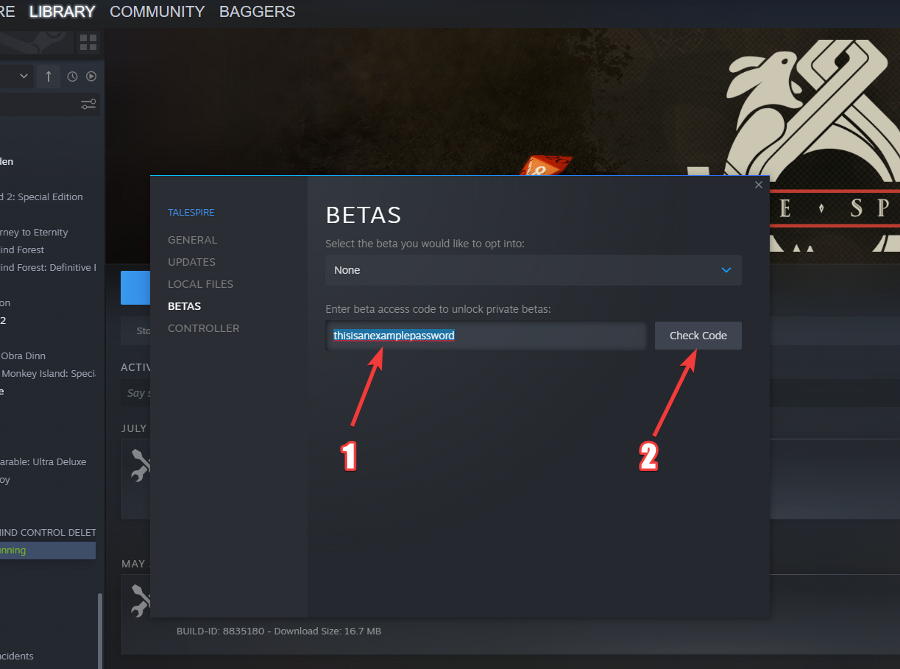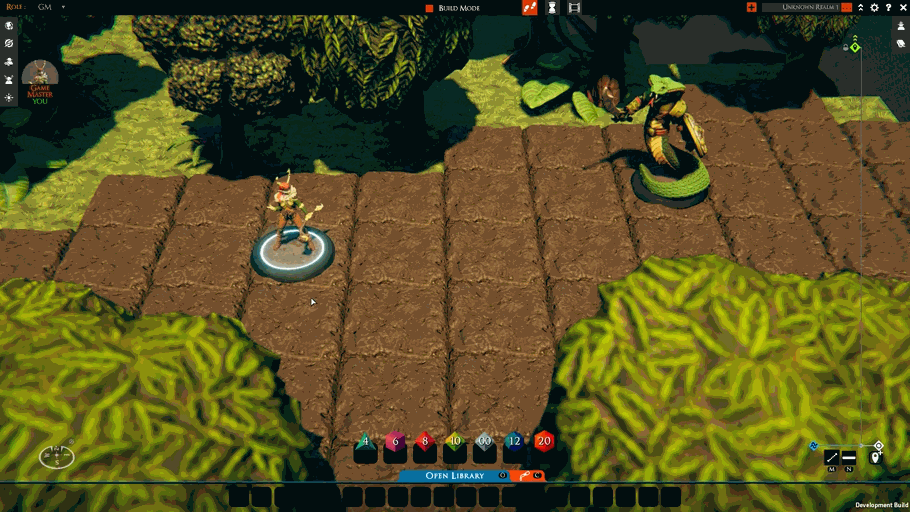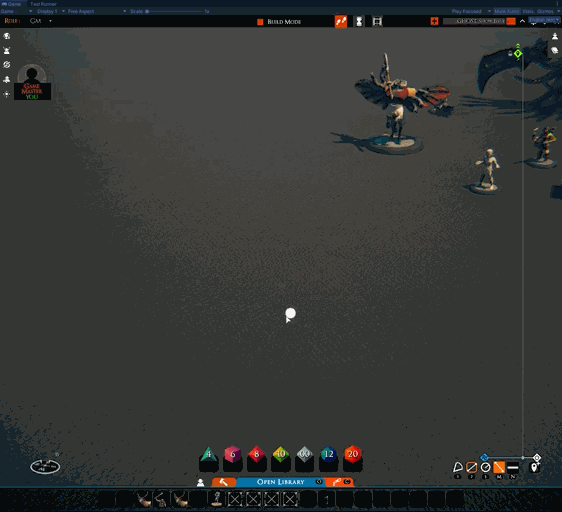From the Burrow
TaleSpire Dev Log 344
Heya folks. Today I’ve been working on the feature to allow region changing. The basics now work:

I’m still working on the code that handles what happens for players who are currently in the campaign. It technically works, but it’s ugly right now.
Seeya!
Disclaimer: This DevLog is from the perspective of one developer. So it doesn’t reflect everything going on with the team
TaleSpire Dev Log 343
Polymorph beta and Dev stream coming this week
Hey folks,
This week polymorph is going to become available for testing. We are rolling this feature out differently than usual, so I thought it would be good to explain the process and why we are doing it.
Also, now that I have moved house, I finally have decent internet speeds again, so it’s time to bring back developer streams. Details are towards the end of this log.
Polymorph Beta
The short version is that we will be making polymorph available on a beta branch of TaleSpire so that the brave and wreckless can try it out and report bugs before we push it out to everyone else.
We’ve wanted to start doing this as it allows us to catch critical bugs without doing damage to existing creations.
-AND-
We also know that even though they are unsupported, there are folks out there hacking the game to make mods. We’d like to give them a bit of time to update their work to fix anything that isn’t compatible with changes to the game.
To this end, the polymorph beta will be opt-in and take place on an entirely different backend from the one you are currently playing on. And that backend will only last for the duration of the testing. That means that when we release the feature to everyone, the test backend will be shut down, and everything that was on that branch will be cleared.
The process to opt-in will be something like this:

- You will open the Steam beta properties for TaleSpire
- You’ll enter a password we give out later this week
- You’ll be given the option to opt into the beta
- If you do, the game will update, and then you will be on our testing build and backend
Opting out is as simple as setting the beta back to “None.”
We’ll have full instructions and warnings out on the day.
Dev Stream
Yup, we are finally doing a dev stream again. We will be live on twitch.tv/bouncyrock this Thursday at 11pm Norway time (click the link above to see the time in your timezone.
This will be a general catchup. As usual, you’ll have the opportunity to fire questions at us too.
That’s all for today
That’s all the news for today, there has been plenty of code and art work going on, but we can save that for another dev-log.
Ciao!
Disclaimer: This DevLog is from the perspective of one developer. So it doesn’t reflect everything going on with the team
TaleSpire Dev Log 342
Heya folks,
Last night I pushed a server update containing code needed for polymorph, HeroForge pack grouping, and tracking photon errors. Aside from one hiccup, it all went well.
The last few days have been a mix. My Sunday and Monday were mainly working on moving house stuff. I’ve got a little cabin thing I’m using as an office, so I dug a trench and laid conduit to get internet out there. That is working great, so I’ll need to work out my streaming setup again so we can do some catchups.
I’ve just merged a pile of polymorph work into master. It’s slowly getting more stable, although I still have some pressing bugs to fix before we can push it out.
I’ve got to head out now to get a vaccine for tick-borne encephalitis, as the area I’m in is pretty forest’y. When I get back, I’ll be working on HeroForge. I need to focus on the biggest pain points there so we can get it out of beta status. I’d like to get file hash validation done, and then I’ll see how far I can get on texture rescaling today[0].
The next week or so will still be a bit hectic for me (due to life stuff), but everything is going in a great direction.
See you around.
Disclaimer: This DevLog is from the perspective of one developer. So it doesn’t reflect everything going on with the team
[0] Currently, our assets file sizes are way bigger than they need to be due to working around a Unity bug where their texture quality setting breaks DXT textures. I’m hoping I can rescale the textures so that sizes at each mip level will be a multiple of four (required for DXT) regardless of the texture scaling their quality setting uses.
TaleSpire Dev Log 341
Heya folks.
I’ve now packed up my computer, ready for the move, but I did get some stuff done before then.
I’ve made the first pass at including groups in the HeroForge browser.

I’ve merged the polymorph UI branch into my dev branch and am currently working on bugs. Currently, I’m updating the code to push scale along with the morph data so that players get the correct result even if the asset hasn’t finished loading yet.
The scale work required back-end updates to make unique-creatures handle this correctly. That is done and is looking good so far in testing.
I think that’s the interesting stuff for now. I should be set up for work by Monday, so I’ll see you then.
Ciao
Disclaimer: This DevLog is from the perspective of one developer. It doesn’t reflect everything going on with the team
TaleSpire Dev Log 340
‘Allo folks!
We’ve been chugging away on fixes and features as usual. With a long weekend coming up, we’ve been working hard to make sure things are as stable as possible for those days.
HeroForge made minis from packs available to TaleSpire yesterday. This rollout was not perfect, and we uncovered some details that had slipped by us. We’ve been chasing down issues that resulted from that, and once we push out a small patch later today, we should have workarounds for the most egregious bugs.
Next week I will be looking to improve the speed of fetching the HeroForge data. Currently, it’s pretty slow for large collections.
While fixing the above and the other TaleSpire bugs, I’ve also started work on “move-rulers.” These will be a feature you can control locally, and the first version looks like this:

This should be a nice, lightweight complement to tactical rulers.
Not much work remains for the move-rulers feature. I need to add some UI for toggling it on or off and to clean up a few edge cases.
Until next time,
Peace.
Disclaimer: This DevLog is from the perspective of one developer. So it doesn’t reflect everything going on with the team
TaleSpire Dev Log 339
Hi again folks,
Work continues at speed over here. We will have another patch out for you pretty soon that fixes some mouse glitching, scroll speed issues, and a bug that meant people were stuck on the main menu.
As well as that, work has restarted on other features. I’ve been working on one nicknamed “tactical rulers.” The idea is that in tactical play, it is often nice to be able to leave the ruler on the table for a minute while doing things like moving creatures. This feature seeks to support that.

Note: this is an early test, hence the unused icon in the menu
Another benefit is that, in the future, we can add more features to the ruler right-click menu, such as turning them into markers for area-of-effects spells and such.
That’s all for the moment,
I hope you have a great day.
Disclaimer: This DevLog is from the perspective of one developer. So it doesn’t reflect everything going on with the team
TaleSpire Dev Log 338
Hellooo!
We have passed the first 24 hours of having shipped the HeroForge integration, and things are going well!
I’ll be honest that there were so many moving parts to this that I was expecting everything to be on fire at this point. It’s nice to be wrong.
Yesterday’s release included not only HeroForge support, but also:
- the vast majority of the code for the polymorph feature
- a jump to the latest version of Unity
- changes we needed to revisit creature copy/paste.
Today I’ve been working on bugs, a couple of which I’ll highlight here:
One is a regression to some of the sign-in code, which has left a few people stuck on the main menu.
Thanks to a community member, we’ve been able to get some very helpful logs, and we are testing some possible fixes over the coming days.
Another issue was that minis with transparency were failing to convert. While we aren’t supporting translucent HF minis, we don’t want the conversion to simply fail. It turned out that the issue was that those minis were missing a texture that we otherwise expected to be there. I added a new code path to handle this case.
In the near future, HeroForge will be updating their site to give more information about what is supported. So hopefully, there will be much less chance of unwelcome surprises then.
That’s probably the most interesting stuff I have to say for now. I’m diving back into feature work now! I think I will continue working on the next version of the rulers feature. Until next time.
Peace
Disclaimer: This DevLog is from the perspective of one developer. So it doesn’t reflect everything going on with the team
TaleSpire Dev Log 337
Long time no dev-log!
Just a quick heads up to let you know that there will be brief server maintenance on Monday, 25 April 2022, 10:00:00 UTC
You can see what time that is in your region here: https://www.timeanddate.com/worldclock/fixedtime.html?msg=TaleSpire+Server+Maintenance&iso=20220425T12&p1=187&ah=1
We have scheduled one hour for the work, but we will only be using all of that if something goes wrong. The expected downtime is under a minute.
This maintenance is in preparation for an upcoming feature release :)
Have a good one folks.
Disclaimer: This DevLog is from the perspective of one developer. So it doesn’t reflect everything going on with the team
TaleSpire Dev Log 336
Hi folks,
You may have noticed that I’ve been gone for about a week. The reason for that was that I caught the flu, and it’s been doing a merry dance on me since then.[0]
I’m not entirely back to normal, I still run out of energy after about five hours of being awake, and my coughing sounds like some satanic accordion. But I am on the mend.
My sincere apologies to those of you who I’m meant to have contacted. It simply hasn’t been possible. I’ll catch up when this passes.
For those wondering, yes, this did affect the HeroForge release date, although it has not changed the month it is happening. Also, this has not given us extra time for polish, as I’d haven’t been able to code at all while ill (which has been driving me crazy!). That said, other TaleSpire work has continued, and Ree’s latest post is mind-blowingly exciting.
Here in Norway, we have Easter break rapidly approaching, so we will be away for that. Ree will be along with another dev-log talking about that, though.
Thanks for bearing with us, folks. I can’t wait to be back working while not rattling.
Take care
Disclaimer: This DevLog is from the perspective of one developer. It doesn’t reflect everything going on with the team
[0] I did test that it wasn’t COVID, which was a relief.
TaleSpire Dev Log 334
Hey folks, I’m quite frazzled today so no proper update of what’s going on. I can say though, that it’s all going well, and we are still expecting the beta launch to happen on the same date that we still aren’t telling you :P
In lieu of text content, have some video content!
This is a speedy video showing the process of connecting a HeroForge account, linking some creatures to the campaign, and showing how things respond to being unlinked and relinked.
We are still working on bugs[0], and the UI is still changing. However, we are excited to make the experience as smooth as possible. So that this could be done effortlessly, even in the heat of battle.
Please note that you do not need a HeroForge account to play with miniatures created by other players, even if you are the GM. An account is only required for sharing your creations with a campaign.
Alright, I’m heading out.
Have a good one!
Disclaimer: This DevLog is from the perspective of one developer. So it doesn’t reflect everything going on with the team
[0] that ugly lag when opening the HeroForge menu is already fixed, for example.